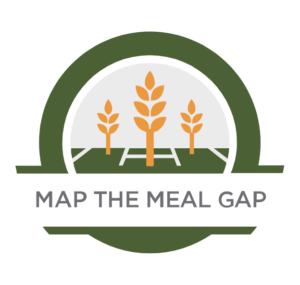Study shows the amount of money people facing hunger need to be food secure reaches highest level in 20 years

The extra amount of money that people facing hunger said they need to have enough food reached its highest point in the last 20 years, according to Feeding America’s annual Map the Meal Gap study. At the local level, Map the Meal Gap finds that $70 million is needed to make up for the annual meal gap of 16 million meals on the Treasure Coast. Treasure Coast Food Bank is one of more than 200 food banks that are part of Feeding America’s nationwide food bank network.
Map the Meal Gap is the only study that provides local-level estimates of food insecurity and food costs for every county and congressional district. The study builds upon the USDA’s latest report of national and state data, which showed a sharp increase in food insecurity in 2022 amidst historically high food prices and the expiration of many pandemic-era programs. Map the Meal Gap emphasizes the urgent call for all of us to take action.
“This year’s study reaffirms what individuals experiencing hunger have been telling us: rising food costs are making hunger in America worse, and it is still continuing into 2024,” noted Judy Cruz, President & CEO of Treasure Coast Food Bank. “This valuable resource aids our comprehension of food insecurity’s ramifications, emphasizing our collective ability to end hunger in America through unified national efforts.”
Other key findings of Map the Meal Gap include:
Food Insecurity by Geography:
- Food insecurity impacts communities in every county, parish and congressional district in the U.S.
- Estimated food insecurity levels vary across regions, influenced by factors like unemployment and poverty rate as well as policies and practices rooted in history that continue to hold people back today.
- In Florida, food insecurity ranges from a low of 9.6% to 19.6%. Treasure Coast Food Bank sees food insecurity levels ranging from a low of 12.1% in Martin County to a high of 15.8% in Okeechobee County.
- Nationally, child food insecurity rates can reach almost 50% in some counties. Here in Florida, it can reach as high as 35.3%, and Okeechobee County is among the Top 20 Counties in Florida with the highest child food insecurity rate at 23.8%.
Income and Food Spending:
- Nearly 50% of people facing hunger may not qualify for SNAP benefits due to income thresholds. Here on the Treasure Coast, the percentage is nearly 40% of people facing hunger may not qualify for SNAP.
- The national food budget shortfall, which reflects the extra money that people who are food insecure report needing to cover their food needs, has hit a record high of $33.1 billion, up nearly 43% from the previous year. This translates to $24.73 a week per person, on average.
- Residents of the Treasure Coast feel this first-hand, with an estimated food budget shortfall of $105.88 a week for a family of four.
Food Costs and Meal Prices:
- The national average cost per meal has increased to $3.99, marking a nearly 3% increase compared to the prior year and reaching its highest point in the last two decades, even after adjusting for inflation.
- On the Treasure Coast, the average cost per meal is $4.27, which reflects the growing need we see at Treasure Coast Food Bank.
Food Insecurity by Race and Ethnicity:
- While nationally nearly 40% of the food insecure population in the U.S. is white, food insecurity rates among Black and Latino individuals exceed those of white individuals in most counties. We find here on the Treasure Coast similar breakdowns by county.
- Racial disparities persist, with significant variations in food insecurity rates across different racial and ethnic groups and geographic locations.
The Map the Meal Gap study is supported by Conagra Brands Foundation and NielsenIQ/NIQ. Additional key takeaways from the report can be found on the Map the Meal Gap website along with an interactive map that details food insecurity by geography, income, race and ethnicity.
Methodology:
Map the Meal Gap uses publicly available data from the USDA ERS, U.S. Census Bureau and Bureau of Labor Statistics to estimate local food insecurity at the county, congressional district and state levels. The study also estimates local meal costs and food budget shortfalls using food price data from NIQ based on the USDA Thrifty Food Plan, and grocery sales tax data for every county and state in the country.
To learn how food insecurity impacts your community, visit FeedingAmerica.org/MaptheMealGap. For more information about Treasure Coast Food Bank and how to help end hunger on the Treasure Coast, visit www.stophunger.org.
About Treasure Coast Food Bank
Treasure Coast Food Bank is the only food bank and largest hunger relief organization on Florida’s Treasure Coast, providing the community each year with millions of meals valued at more than $50 million through robust programs and in partnership with 300 charitable organizations in Indian River, St. Lucie, Martin, and Okeechobee counties. In addition to emergency food distribution, Treasure Coast Food Bank operates a full roster of direct service programs that not only solve the immediate problem of hunger, but help individuals and families gain long-term food security, better health outcomes, and self-sufficiency. Treasure Coast Food Bank is a Partner Food Bank of Feeding America, the nationwide network of 200 food banks that leads the fight against hunger in the United States. For more information on Treasure Coast Food Bank, stophunger.org or follow us @TCFoodbank on Facebook or Twitter.
About Feeding America
Feeding America® is the largest hunger-relief organization in the United States. As a network of more than 200 food banks, 21 statewide food bank associations, and over 60,000 agency partners, including food pantries and meal programs, we helped provide 5.2 billion meals to tens of millions of people in need last year. Feeding America also supports programs that prevent food waste and improve food security among the people we serve; brings attention to the social and systemic barriers that contribute to food insecurity in our nation; and advocates for legislation that protects people from going hungry. Visit www.FeedingAmerica.org, find us on Facebook or follow us on Twitter.
Treasure Coast Business is a news service and magazine published in print, via e-newsletter and online at tcbusiness.com by Indian River Media Group. For more information or to report news email news@indianrivermedia.com
